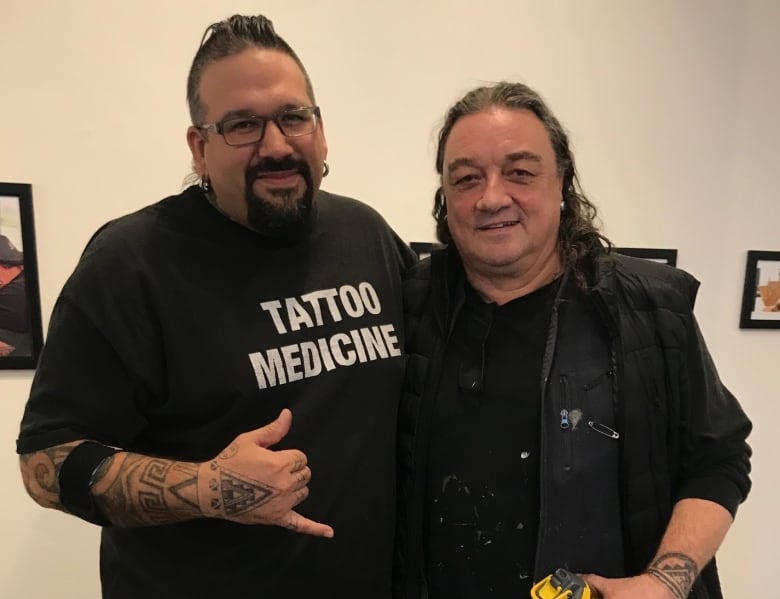These Indigenous artists are working to keep traditional tattooing alive | CBC News

For Dion Kaszas, reviving tattoo traditions almost lost over the course of colonization is an important tribute to his ancestors’ resilience.
“There were so many times where our ancestors could have been extinguished,” said Kaszas.
“Our tattoo designs … are proof and evidence of those ancestors who prayed, cried and survived so that we could be here today.”
Since 2012, Kaszas has worked as a cultural tattoo practitioner and teacher, reviving the tattooing tradition of his ancestors the Nlaka’pamux, an Indigenous First Nation based in southern British Columbia.
He has since been passing on his knowledge, giving talks and teaching the art of traditional tattooing. Kaszas spoke at the Spirit Song Festival last weekend, organized by the First Light Friendship Centre in St. John’s.
“For us, a way that you share your wealth or show your wealth is by giving it away,” says Kaszas. “This is a gift that the creator has given me, and so it’s my responsibility to pass it on and to share it with others.
“And the reality is that I wouldn’t want to come to a place where this practice has to be revived again.”
Permanent regalia
One of the students Kaszas shares his gift with is Mi’kmaw artist Jerry Evans.
The St. John’s artist, originally from Grand Falls-Windsor in central Newfoundland, first met Kaszas in 2016 at the Indigenous Earthline Tattoo School held by Kaszas and another tattoo artist, Jordan Bennett, in Kelowna, B.C.

There, Evans learned the art of tattooing and also received his first tattoo.
For Evans, it is important that tattoos are meaningful, especially when they include Mi’kmaw motifs.
“It’s a great opportunity to gift people these marks so that they can wear proudly these symbols that represent their ancestry and they wear with pride as permanent regalia,” said Evans.
“When I look in the mirror or see my own skin … it just reminds me of who I am and where I come from.”
Traditional tattoos, Evans said, are a part of Mi’kmaw material culture. “They are marks of our people,” said Evans. “So much has been lost here.… But everybody who lived around us had a tattooing practice. So chances are we did as well.”
Traditional motifs
Evans’s tattoos also show traditional motifs that matter to Mi’kmaq. A circle around his arm represents waves, a symbol for the encompassing role water plays in Newfoundland. Another tattoo shows caribou tracks to represent the importance of the animal.
Growing up, Kaszas didn’t know that tattoos had once been an integral part of Nlaka’pamux culture. He became aware of the practice with a discovery in a tattoo parlour in 1996 — a 1930 publication by anthropologist James Teit titled Tattooing and Face and Body Painting of the Thompson Indians, the archaic term for Nlaka’pamux.
When he found it, Kaszas couldn’t believe his eyes.
“I was like, what? My ancestors tattooed? I had no idea,” said Kaszas.
More than 10 years later, in 2009, Kaszas started researching Nlaka’pamux tattooing traditions which started going out of use around the mid-nineteenth century.

Shortly after, he started practising them himself using hand tattooing methods called hand poke and skin stitching.
Hand poke is the tattoo practice of using a sharp instrument, such as a sharpened bone, fish spine or, more recently, metal needles, to press ink into the skin.
A multitude of designs is used in Nlaka’pamux tattoos but Kaszas says they often represent the people’s connection to the land but also their spirituality and worldview are commonly expressed.
Kaszas says, for him, the tattoo designs are Nlaka’pamux visual language.
“The reality is that the tattoo patterns, designs and motifs are related to basketry designs, painted, rock art, pictographs, petroglyphs, also painted clothing,” said Kaszas.
“It’s really a language that is evident all across our whole visual and material culture.”
Read more from CBC Newfoundland and Labrador
For all the latest entertainment News Click Here

